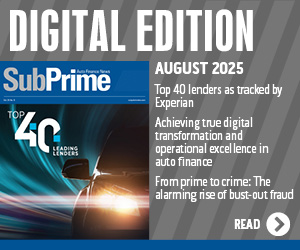Few signs industry is backing off record financing pace

Photo from Shutterstock.com
The latest report generated by the Federal Reserve Bank of New York declared that 2016 officially represented the year of the highest auto finance originations — at least in the 18-year history of the data officials obtained from Equifax.
And at least one finance company that specializes in subprime paper isn’t sure when the current cycle of aggressive originating is going to slow.
The New York Fed indicated there were $142 billion in auto originations during the fourth quarter, leaving the amount of outstanding balances at $1.16 trillion, roughly $93 billion higher than the close of 2015.
In the company’s letter to shareholders distributed this week, Credit Acceptance chief financial officer Kenneth Booth tried to leverage past credit cycles to project what might happen for the rest of this year and beyond.
Booth told Credit Acceptance shareholders that he expected the current origination cycle to unfold similar to the one that began in 1994, which lasted four years, as well as the one that started in 2003, which stretched on for five years. He acknowledged the current cycle began in 2012 and now is working toward a sixth year.
“While much has been written about an imminent collapse of our industry, so far those predictions have not materialized,” Booth wrote. “The first two cycles ended for different reasons. In the mid-1990s, it was mistakes made within our industry that caused the cycle to end. Like us, others in the industry grossly misjudged the performance of the loans they were originating. In contrast, the end of the 2003–2007 cycle had very little to do with anything that occurred in our industry, but instead was due to the global financial crisis triggered by the collapse of the housing market.
“As I write this letter, it is difficult to see anything on the horizon that will cause this current cycle to end,” he continued. “Some might point to a decline in used vehicle values (which adversely impacts loan performance), although so much has been written about this that I expect many in the industry have already factored it into their models. Some might point to an expected rise in interest rates, although it would seem to be relatively simple for the industry to gradually adjust pricing models to offset any increase in rates.
“Although I continue to believe that we will have a more favorable environment at some point in the future, my long-term outlook has changed,” Booth went on to say.
Booth then mentioned that the current environment “may be the norm,” while the period that included the Great Recession “may be the exception,” in reference to the span from 2008 through 2010.
“While this is not much more than a guess on my part, and I try to avoid making predictions about the future, I think it’s important to share my thoughts with shareholders, even when those thoughts may prove to be incorrect,” Booth wrote. “In my view, it seems likely that the markets that supply capital to our industry may have figured out how to protect themselves by structuring financing transactions with a margin of safety.
“There is much more information available today and a much longer historical track record upon which they can base their conclusions. If so, capital availability may at times be modestly more restricted, but a complete exit of capital sources from our industry as occurred in the mid-1990s and after the financial crisis may not occur for many years,” he continued.
So where do current conditions leave Credit Acceptance and perhaps other finance companies, especially ones that book subprime paper?
“If this is true, we will need to accelerate our ability to adapt to a competitive cycle that lasts much longer than we hoped,” Booth wrote. “For us, this means continuing to focus on our product and our culture, but also recognizing that it will be critical to make progress more rapidly.
“What we don’t plan to do is grow volume by taking risks we view as unwise. Instead, we will continue to invest your capital in ways we think make sense and return the rest to you,” he added.


